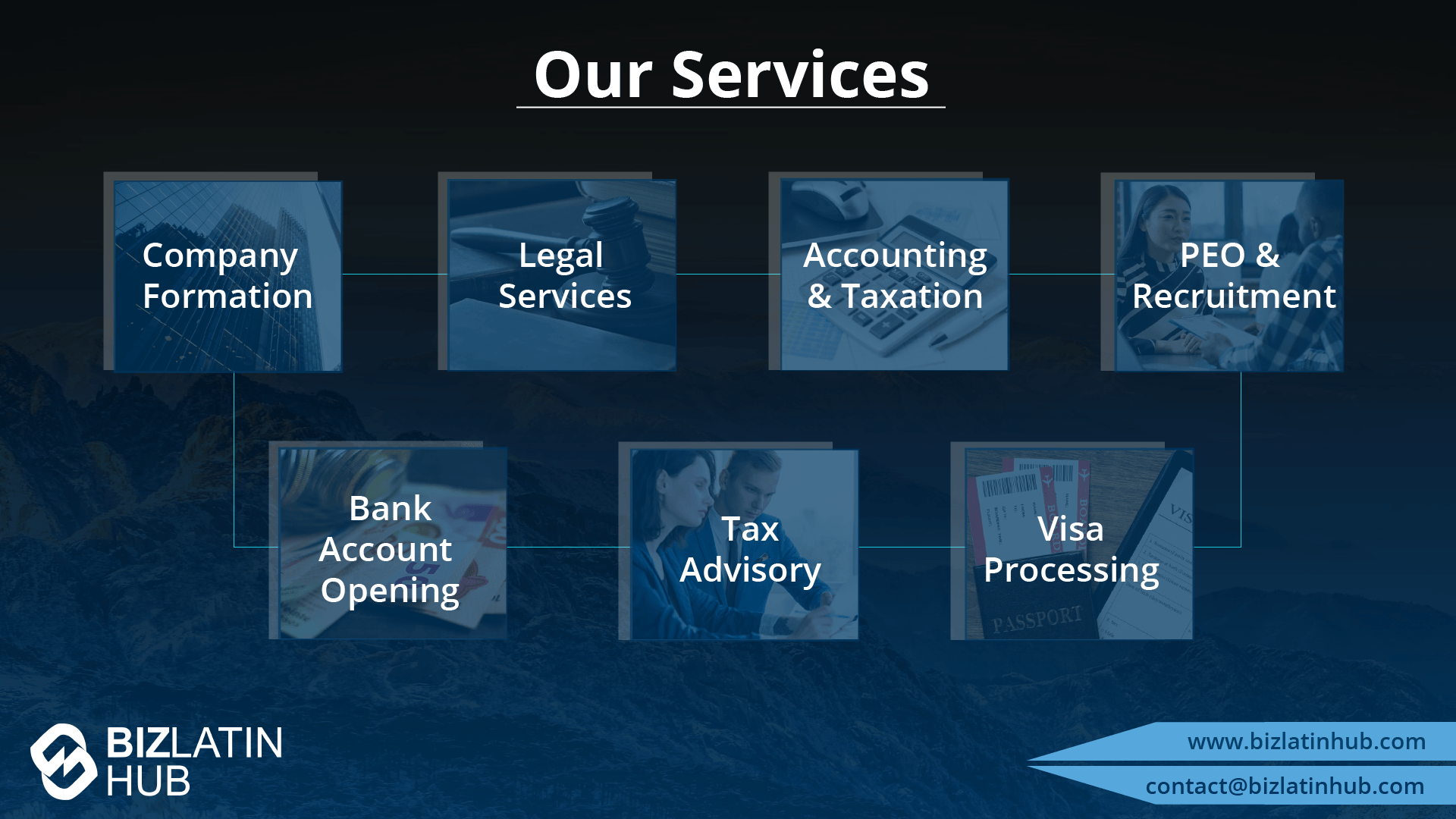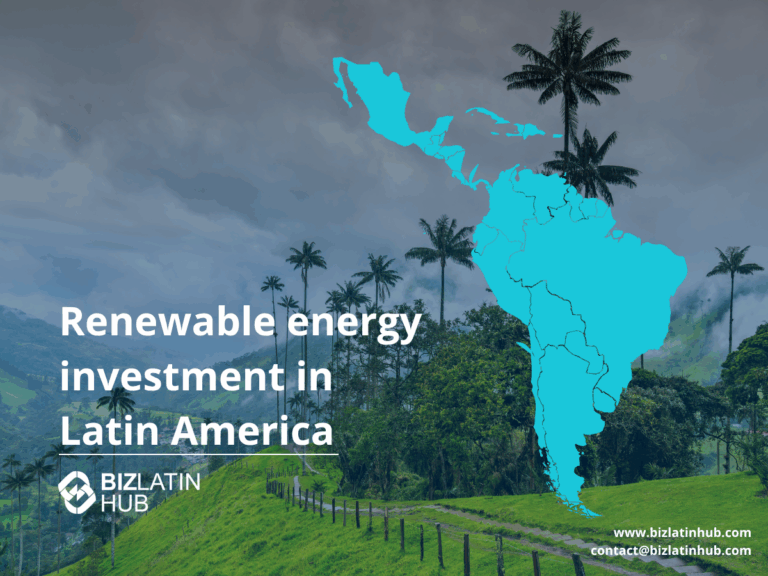As the global economy shifts towards a low-carbon future, more companies are considering renewable energy investment in Latin America. The region has abundant resources, attractive government incentives, and a growing demand for sustainable infrastructure in response to the global green transition.
Latin America holds a renewable energy investment portfolio valued at USD$253 billion, with standout markets including Chile, Brazil and Colombia, each of which focuses on a different energy source. The region presents a unique opportunity for foreign companies to invest and expand into the Latin American market.
Biz Latin Hub can support you with such a venture, providing our full suite of back-office services to help with company formation in any of Latin America’s emerging clean energy markets via our network of dedicated local offices across the region.
Key Takeaways on Renewable Energy Investment in Latin America
What is the difference between conventional and non-conventional energy? | Conventional energy sources like coal and oil are non-renewable, while non-conventional sources such as solar and wind are renewable. |
What are the main incentives for renewable energy investors in Latin America? | Incentives vary by country but commonly include tax breaks, customs exemptions, feed-in tariffs, and access to green financing. |
How does Latin America’s energy mix compare globally? | Latin America has one of the cleanest energy mixes in the world, with over 60% of electricity coming from renewable sources. |
What types of renewable energy dominate in Chile, Brazil, and Colombia? | Chile focuses on solar due to its high irradiance zones, Brazil capitalizes on consistent wind patterns, and Colombia leverages its mountainous terrain for hydroelectric generation. |
The Last Decade of Growth: Renewable Energy Development in Latin America

Two thirds of energy comes from renewable sources in Latin America, while fossil fuel usage has declined by 12% in the last ten years. Hydroelectric power has been the main source, accounting for 41%, with combined wind and solar following with 17% of the clean energy supply.
The region aims to reach 70% of energy sources coming from renewables by the end of the decade. With over 1,700 green projects in the region, attracting USD$113 billion in investment, Latin America has proven to be the perfect candidate for renewable energy investment.
Areas such as solar, wind and hydroelectric power will require significant capital investment if this target is to be reached. Many governments are offering fiscal incentives to encourage financing for these projects. USD$431 billion in investment is needed across the region by 2040 to meet the goal of sourcing 70% of energy from renewables by 2030. This makes Latin America a prime region for green investment opportunities.
Chile’s Solar Power Surge: A Bright Spot in Latin America’s Energy Transition
Chile is at the forefront of the growing renewable energy investment in Latin America with its focus on solar power. In 2023, 9.4% of Chile’s primary energy came from solar, making it a global leader.
The country aims to reach carbon neutrality by 2050 and has therefore implemented a range of government incentives to attract and support investment:
- Small and medium-sized enterprises are eligible for tax exemptions until 2035 on renewable energy projects, with solar projects receiving up to 15 years of tax relief.
- The government has allocated USD$1.2 billion in subsidies for energy storage initiatives, a core area of focus, especially in the Atacama Desert in the north of the country.
The European Investment Bank has recently loaned USD$110 million to Banco Estado de Chile in order to finance renewable energy projects and energy efficiency investments. This will be available for small and medium-sized businesses. This marks a significant milestone in Chile’s sustainable infrastructure development and means that it is the perfect moment to invest in their green transition opportunities.
One main focus for Chile’s clean energy market growth is reducing curtailment, so less renewable energy is wasted and investors earn more. Investment in batteries, grid improvements and demand-side response are the main focal points for this. Funding in these areas will help Chile reach their maximum potential in renewable generation.
Harnessing the Wind: Brazil’s Expanding Wind Energy Sector
Brazil has been breaking records with its wind energy generation, producing over a fifth of its electricity from wind renewables in August 2025. Wind has almost doubled its share of Brazil’s electricity generation since 2019, helping the country to successfully diversify away from fossil fuels.
The Brazilian government offers many different tax incentives, making the cost lower to build wind farms:
- A zero federal tax rate applies to the importation of most wind turbine components, exempting them from employer contributions.
- Delayed tax payment for the operation of machines involved in the capture and generation of wind energy.
- The same taxes (known locally as ICMS) are exempted for the sale, movement or importation of wind turbines in any part of Brazil.
With these tax breaks in place, wind energy is becoming cheaper for developers and consumers as well as improving financial returns.
At the beginning of 2025, Brazil’s president, Luiz Inácio Lula da Silva, enacted the offshore wind bill, removing parts that would benefit fossil fuels, which means the sector is projected to see massive growth.
That acts as a key opportunity for Brazil to become one of the main global markets for wind energy as well as attract substantial investment and generate significant employment in coastal areas.

Colombia’s Hydropower Potential: Driving Sustainable Energy Solutions
Almost 70% of Colombia’s energy comes from hydroelectric power, ranking sixth globally for countries with the largest renewable water resources. The sector has been propelled by private initiatives and public-private partnerships, allowing the country to reach such impressive figures.
The government has incentives and tax exemptions in place. Eligibility is contingent upon meeting environmental criteria and mostly only applies to small-scale hydroelectric projects:
- 50% deduction of income tax on investments related to research, development and production of electric energy with non-conventional sources over the first 5 years of investment.
- Exemption from VAT on domestic purchase and/or importation of machinery and services for renewable energy sources.
- Investors will not pay duties and/or tariffs on the importation of machinery, equipment, inputs and materials that are destined to be used in the investment stages of the projects.
There has been a bigger focus on small-scale hydroelectric projects recently, with Colombia having the potential to generate 25GW from small-scale projects alone. There are currently over 100 operational and the same again in development, alongside growing momentum for public-private partnerships to increase growth and investment in the sector.
The rising demand for renewable energy in Colombia reflects an increasing awareness of socially and environmentally responsible projects. This aligns with the government’s focus on promoting small hydroelectric power energy initiatives that minimize ecological impact.
The ‘BIG Small Hydro 2025’ conference in Medellín exemplified this approach, emphasizing the benefits of smaller-scale initiatives and Colombia’s appeal as a destination for sustainable investment in Latin America.

Looking Ahead: Investment Opportunities in Latin America’s Low-Carbon Economy
The investment potential for renewable energy in Latin America extends well beyond the technologies and countries highlighted in this article. With a diverse energy matrix and strong policy backing, the region is rapidly positioning itself as a new global leader in renewable energy. This foundation enables Latin America to scale new technologies such as green hydrogen, energy storage, and electric mobility, further diversifying investment opportunities.
Many countries have set green transition goals, making it one of the most attractive regions for low-carbon investment worldwide. For foreign investors, this represents a timely opportunity to engage with a market that combines natural resource abundance, policy stability, and growing demand for sustainable infrastructure.
Frequently Asked Questions about Renewable Energy Investment in Latin America
Latin America offers abundant natural resources, strong government incentives, and a clean energy mix with over two thirds of electricity already comes from renewables. The region is also targeting 70% renewable energy by 2030, creating significant investment opportunities.
Yes. Countries like Chile offer long-term tax exemptions and subsidies for SMEs.
Curtailment refers to the reduction of energy output due to grid limitations. In Chile, reducing curtailment through battery storage and grid upgrades is key to maximizing solar energy potential and investor returns.
Yes. Brazil recently passed an offshore wind bill, removing fossil fuel advantages and paving the way for large-scale offshore wind development along its extensive coastline.
Colombia is prioritizing small-scale hydroelectric projects to minimize environmental impact. These initiatives are often supported through public-private partnerships and community-based models.
At Biz Latin Hub, we’re ready to support your expansion into renewable energy investment in Latin America. We provide integrated market entry and back-office services throughout Latin America and the Caribbean, with offices in major cities in the region.
With our full suite of back-office solutions, including legal, accounting, and recruitment services, we can be your single point of contact to help you enter and operate in any of the countries around Latin America and the Caribbean where we operate.
We also have trusted partners in many other markets. Our unrivaled reach means we are ideally placed to support multi-jurisdiction market entries and cross-border operations.
Contact us today to learn more about how we can assist you in doing business in Latin America and the Caribbean






